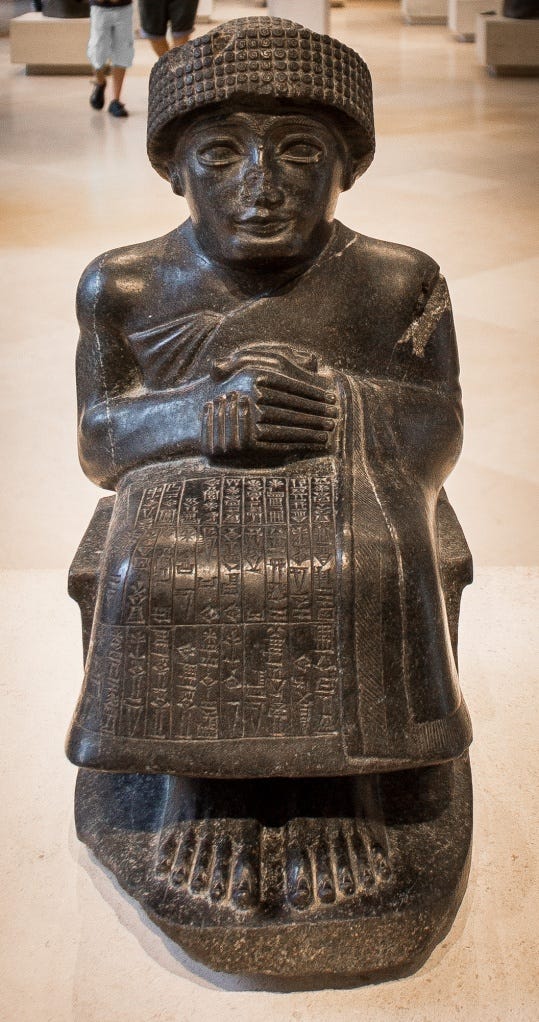The Louvre: Gudea & Stela of King Naram-Sin
Two anonymous artists give us a lesson in Far Eastern History
Entering Salle 2 (Room 2) of the Richelieu Wing of the Louvre, I was greeted by many similar-looking statues with distinctive headresses. (Well, on those with intact heads anyway!)
I overheard a little boy entering the room say contemplatively and with wonder, “There’s lots of stones in here...lots of stones…” (Smile.)
Indeed, these are stones - twelve votive images - carved from diorite, an igneous rock composed of basalt and granite, and they depict one of Sumeria’s last great rulers, Gudea, Prince of Lagash. Lagash was a city-state located in what is now southeastern Iraq (ca. 2120 B.C.). The statues were originally housed in temples rebuilt by Gudea and were dedicated to his personal god, Ningishzida.
Gudea’s name means “the destined.” (Quite auspicious!)
In this, the only complete and most-detailed rendition, Gudea wears a royal turban and a royal robe with a cuneiform inscription, has distinctive "fishbone" eyebrows, and his hands are folded in prayer. It is presumed he is praying for redemption for his people from invading barbarians. Good thing to pray for!
In stark contrast to the black diorite, in a corner of Salle 2 stands a large pink-coral stone with highly-detailed reliefs. This is the Victory Stela of King Naram-Sin (ca. 2230 B.C.), 4th King of the Akkadian Dynasty. Crafted of pink limestone, it commemorates the battle and ultimate victory of the Akkadians over the Lullubi mountain people (ca. 2250 B.C.) King Naram-Sin climbs to the sun-bathed victorious peak, wearing the horned helmet of a god. The inscription is in two languages: Akkadian and a primitive cuneiform. He is admired by his soldiers who look up to him adoringly while his enemies are trampled under his feet or thrown off a cliff; not a bad place to be, literally and figuratively!
Notice how much bigger and taller King Naram-Sin is relative to the other men in the sculpture. Also note the man trying to remove an arrow from his neck and another pleading for his life. It is a dynamic and graphic story.
I suppose the little boy was right: there are a lot of stones in Salle 2 of the Richelieu Wing. But, on close inspection, these "stones" are so much more and we, thousands of years into the future, thanks to unknown artists/craftsmen, are the recipients of lasting depictions of two powerful rulers from the Dawn of Civilization: Gudea, Prince of Lagash and King Naram-Sin.
References:
Gudea, Prince of Lagash, seated statue dedicated to the god Ningishzida. http://www.louvre.fr/en/oeuvre-notices/gudea-prince-lagash-seated-statue-dedicated-god-ningishzida
Victory Stele of Naram-Sin. http://www.louvre.fr/en/oeuvre-notices/victory-stele-naram-sin








